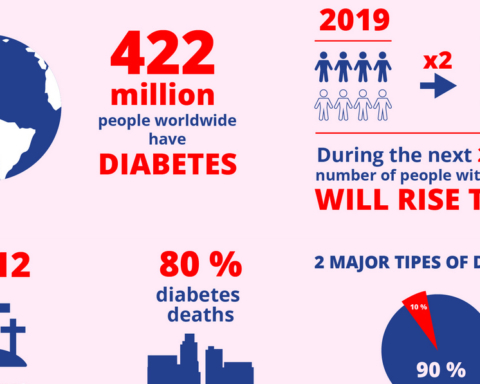Actually, it doesn’t—at least not in the way you think. Diabetes is caused by a genetic predisposition and lifestyle factors, or by an autoimmune reaction. However, in the case of type 2 diabetes, eating excessive amounts of sugar may influence whether or not the genes for diabetes get triggered.
Diabetes mellitus is the formal name for what’s commonly called diabetes—a group of metabolic disorders all characterized by abnormally high blood sugar that results, not from eating sugar, but from insufficient levels of the hormone insulin, which maintains blood sugar (glucose) at normal levels. None of the various types of diabetes, including the more common type 2, type 1, and gestational diabetes, share the same cause, yet none is caused by eating sweet or starchy foods. Type 2 diabetes is caused by defects in either insulin secretion or its action, or in both. In other words, either your pancreas does not produce enough insulin or your body does not properly respond to the insulin it makes. This latter condition is referred to as insulin resistance. Insulin resistance is your own body’s inability to use insulin efficiently, and it prevents your cells from getting enough sugar from your blood stream.
In type 1 diabetes the immune system, which normally protects you from viruses and bacteria, attacks and kills the beta (insulin producing) cells in your pancreas. Within months or a year, the body will produce either just a trace of insulin or none at all. The reasons why this happens are still unclear, but scientists think the causes may be genetic, with one or more environmental triggers. These may include stress, toxins, or a virus. Type 1 diabetes usually occurs in childhood, although you can get it at any age. And, yes, it is very common for patients with type 1 diabetes to mistakenly think they caused their diabetes by eating a sugary diet.
The third most common form of diabetes is gestational diabetes. This form of diabetes is similar to type 2 diabetes, but it occurs only in women during pregnancy. According to the American Diabetes Association, gestational diabetes affects about 4 percent of all pregnant women, or about 135,000 women in the United States each year. The cause is unknown, but it’s believed that hormones from the mother’s placenta block the action of the mother’s insulin. This causes the mother’s blood sugar to rise.
Here’s a great tip for anyone who currently lives with diabetes. Managing your diabetes condition can get quite challenging, especially financially. Thankfully, there are now easy to use online platforms that allow you to make quick cash when you decide to sell your excess or unused diabetic test strips.
How type 2 diabetes develops
When one eats sugar or starch, the blood sugar level rises and the pancreas releases the proper amount of insulin to keep blood sugar within the normal range. In someone with type 2 diabetes, the production and/or action of insulin is inefficient, so after eating your blood sugar goes up but doesn’t return to normal levels. Clinicians look at diabetes not as a sugar problem but as an “insulin inefficiency.” There is, however, an important caveat here: Even though eating sugar does not cause diabetes, “if you have the gene for diabetes, eating an excess of sweets, over time, may accelerate the onset of diabetes by over stressing your beta cells causing them to become compromised,” says Dr. Gerald Bernstein, director of the Diabetes Management Program at Beth Israel Hospital in New York City. Bernstein also says that consuming too many calories and too much fat contributes to insulin resistance, which hastens the expression of the gene(s) for diabetes. Dr. Bernstein advises that if you are at risk for type 2 diabetes and like to eat sweets, you should make sure you get enough physical activity to burn off excess calories and keep your weight in check. This will help neutralize stress to the beta cells. If you have type 2 diabetes, you’ve probably already lost some beta cell function, but maintaining a proper weight and getting regular physical activity can help halt further loss.
If you don’t have the gene for diabetes, then no matter how much sugar or fat you consume, you will not get diabetes, except there’s a caveat here too: your age, says Dr. Bernstein. When you are eighty years old, your beta cells may not work quite the way they did forty years ago and may be unable to withstand the stress of too many sweets or too much weight as they once did.
Increased insulin resistance leads to type 2 diabetes
The onset of type 2 diabetes generally occurs after years of increasing insulin resistance. This early stage of insulin resistance is commonly called pre-diabetes, so named because it typically precedes type 2 diabetes. Studies show that most people with pre diabetes develop type 2 diabetes within ten years. During the early stage of insulin resistance, beta cells are still strong enough to overcome the present insulin resistance, but as insulin resistance increases, the pancreas attempts to secrete greater amounts of insulin, and beta cells become more compromised. Finally, the pancreas can’t produce enough insulin to meet the demand, and blood sugars rise to the level identified as diabetes. The three greatest influences that cause insulin resistance and, as a result, the expression of the diabetes genes are being overweight, being sedentary, and being more than forty-five years old.








